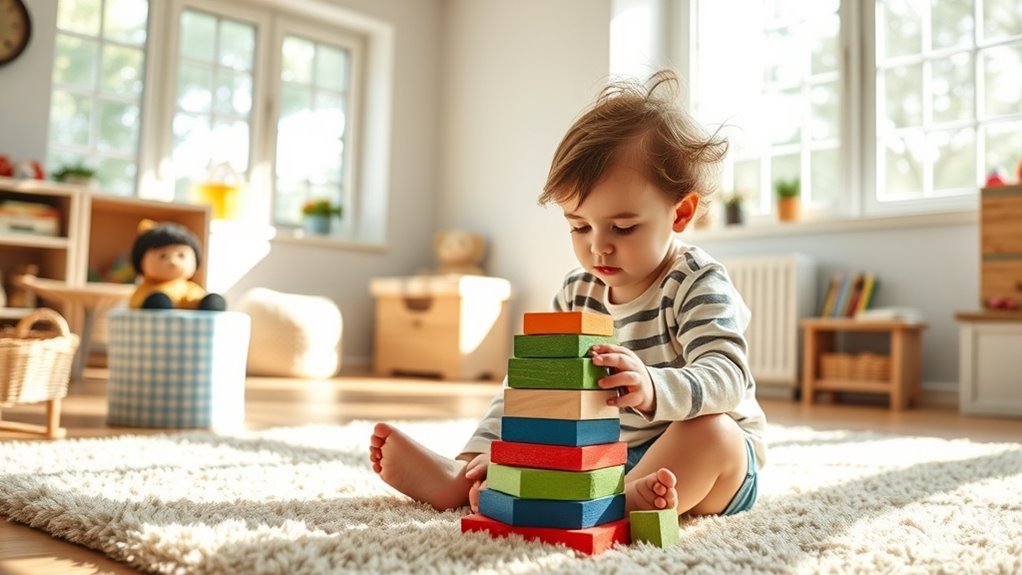To encourage independent play, keep your space organized with designated areas and labeled bins to make toys easily accessible. Offer a variety of open-ended toys and activities that spark creativity and problem-solving. Stay nearby to guarantee safety, but give your child space to explore and make choices. Praise their efforts and persistence to boost confidence. For more helpful tips on fostering independence and creativity, continue exploring ways to create a supportive play environment.
Key Takeaways
- Organize the play area with labeled bins and designated zones to promote easy access and independent initiation of activities.
- Use open-ended toys and materials to stimulate creativity, problem-solving, and self-directed play.
- Gradually increase alone playtime while maintaining supervision to build confidence and autonomy.
- Encourage outdoor exploration and unstructured play to foster imagination and decision-making skills.
- Praise efforts and creativity to boost self-esteem and reinforce positive independent play behaviors.

Encouraging independent play is essential for a child’s development, as it helps build confidence, creativity, and problem-solving skills. When you create an environment that supports self-directed activities, your child learns to trust their instincts and explore their interests freely. One way to foster this independence is through thoughtful playroom organization. Keep the space neat but accessible, with clearly designated areas for different types of play. Use labeled bins and shelves to store toys, art supplies, and books, making it easy for your child to find what they want and put things back when they’re done. An organized playroom minimizes frustration and encourages your child to initiate play on their own, rather than relying on constant guidance or adult intervention.
In addition to an organized indoor space, outdoor activities play a crucial role in promoting independent play. When you encourage your child to spend time outside, you’re giving them opportunities to engage in unstructured play that nurtures their imagination and physical development. Whether it’s building with natural materials, riding a bike, or simply exploring the yard, outdoor activities allow your child to take the lead, make decisions, and solve problems in real-world contexts. Make sure the outdoor environment is safe and inviting, with accessible play equipment and natural elements like trees and open space for creative play. By regularly integrating outdoor activities into their routine, you help your child develop a sense of autonomy and confidence.
It’s also important to set boundaries that foster independence without leaving your child feeling isolated or overwhelmed. While you want to give them space to play freely, stay nearby so they know you’re available if needed. Gradually, you can extend the amount of time they spend playing alone as they become more comfortable and confident. Encourage them to choose activities that interest them and allow room for experimentation. Avoid over-scripting or directing their play; instead, provide a variety of open-ended toys and materials that stimulate their imagination and problem-solving skills. Incorporating independent play with developmentally appropriate toys can further enhance their ability to entertain themselves and learn at their own pace.
Finally, praise their efforts and independence, reinforcing the idea that they’re capable of entertaining themselves and managing their play. Recognize their creativity and persistence, which boosts their self-esteem and motivates them to continue exploring on their own. By combining organized play spaces, outdoor exploration, and supportive boundaries, you create an environment where independent play flourishes, helping your child develop into a confident, resourceful individual.
Frequently Asked Questions
When Should I Start Encouraging Independent Play in My Child?
You can start encouraging independent play around your child’s development milestones, typically between 6 and 12 months. Watch for signs of emotional readiness, like your child comfortably exploring toys alone or showing curiosity without immediate reassurance. Begin with short periods of independent play, gradually increasing as they become more confident. This helps foster their independence and emotional growth, building a foundation for future social and cognitive skills.
How Can I Handle My Child’s Resistance to Playing Alone?
Did you know that children often resist playing alone because they’re still developing emotional regulation and peer interaction skills? To handle this, start small by gradually increasing alone time, offering comforting objects, and praising their independence. Encourage peer interaction through playdates so they feel more confident. By being patient and supportive, you help your child build resilience and enjoy independent play, making the progression easier over time.
What Are the Best Toys or Activities for Promoting Independence?
To promote independence, choose educational toys that challenge your child and spark curiosity, like puzzles or building blocks. Incorporate sensory activities, such as textured mats or water play, that encourage exploration. These toys and activities help your child develop problem-solving skills and confidence while enjoying solo play. By providing engaging and age-appropriate options, you foster a sense of independence and make playtime both fun and beneficial.
How Do I Balance Independent Play With Parent-Child Interaction?
Did you know that children who experience balanced independence and parent interaction develop better social skills? To balance independent play with parent-child interaction, use supervision strategies that offer safe boundaries, allowing your child to explore confidently. Watch for signs of emotional readiness, ensuring they’re comfortable before stepping back. Engage in brief check-ins to provide reassurance, then step back to foster independence, creating a healthy mix of autonomy and connection.
Are There Safety Concerns During Independent Play I Should Watch For?
When your child plays independently, you should stay attentive to supervision requirements and hazard identification. Keep an eye on their environment to spot sharp objects, choking hazards, or unstable furniture. Make sure the play area is safe and free from potential dangers. Regularly check for small items they might swallow and ensure toys are age-appropriate. Your vigilance helps prevent accidents, allowing your child to explore safely and confidently.
Conclusion
Encouraging independent play might seem challenging at first, like planting a tiny seed that slowly grows. But with patience, it blossoms into confident, creative children exploring and discovering on their own. Just as a tree stands tall and strong, your child learns resilience and independence through your guidance. So, embrace the quiet moments of play, knowing they build a future where your child stands tall, curious, and capable, ready to face the world with enthusiasm and confidence.










